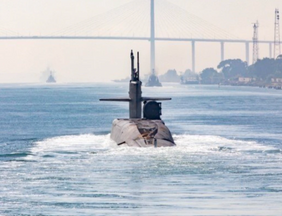Posted by BW Actual on Nov 7th 2023
BLACKWATER USA | DAILY BRIEF
Gaza
- Israel said its troops have completely encircled Gaza City, cutting it off from the rest of the strip ahead of an operation against Hamas's headquarters expected in the next two days.
- Yemen's Houthi rebels claimed - without evidence - their missiles had struck Israeli military bases and airports, but there were no signs of an incursion. It's possible that Jordanian defenses shot down incoming missiles.
- The U.S. said it deployed a nuclear-powered submarine to the region in a show of support for Israel. CentCom posted a photo of an unnamed Ohio-class sub next to the Suez Bridge in the middle of the Suez Canal - although it's not clear whether this was a stock photo or a current picture of the newly deployed (but unidentified) vessel.
- Russia targeted a Ukrainian military medal ceremony near the front lines, killing at least 19 Ukrainian soldiers - and raising questions about why a ceremony was being held in vulnerable territory near the front.
- Ukraine struck back with an assault on Russian warships in Crimea that badly damaged Russia's brand new 220-foot missile carrier Askold. The Ukrainian air force then posted a photo of one of the French-made SCALP missiles it likely used in the Askold strike, quipping: "How was your weekend?"
- Russia then targeted the Ukrainian port city of Odesa with drones and missiles, causing damage to an art museum as well as port facilities.
- Separately, Pres. Zelensky shut down the idea of holding elections as scheduled in March 2024, saying it would be irresponsible to focus on organizing a vote in the midst of a war.
- Russia, on the other hand, is planning to hold elections next spring. Pres. Putin is reportedly planning to run for reelection - having cleared the way to stay in power through 2036 with a referendum over the summer. Assuming he runs, he'll certainly win this poll - whether fairly or by rigging the vote - which would extend his term through 2030.
- Bloomberg reported that Russia is negotiating with Libya's eastern commander, Khalifa Haftar, to build a naval base in the oil-rich east.
- Wagner Group is already quietly operating in eastern Libya; new reports suggest Haftar is now trying to offer Russia permanent docking rights and flight permissions at ports and air bases already used by Wagner in the east in exchange for military training for his forces.
- Rwanda and DRC are both gathering troops along their perpetually volatile border.
- The neighbors have long skirmished over Rwanda's support for M23 rebels in DRC, but this latest flare-up seems more significant than usual: SecState Blinken called Presidents Kagame and Tshisekedi to urge de-escalation.
- The NYT had a great article on the new role of China's Belt and Road Initiative as a lender of last resort for countries that borrowed beyond their repayment means for infrastructure projects.
- Here's a key snippet: "While the Belt and Road Initiative bought geopolitical clout for Beijing and helped finance economically useful projects, Chinese loans were also used to build expensive projects that have not spurred economic growth and have loaded countries with debt they are now unable to repay."
- Full article pasted below.
Instead of lending money for highways and bridges, China has shifted to providing emergency rescues for previous borrowers.
After lending $1.3 trillion to developing countries, mainly for big-ticket infrastructure projects, China has shifted its focus to bailing out many of those same countries from piles of debt.
The initial loans were mostly part of the Belt and Road Initiative, which Xi Jinping, China’s top leader, started in 2013 to build stronger transportation, communications and political links in more than 150 countries.
But now the two main Chinese state banks that provided most of the infrastructure loans have reduced their new lending. Rescue loans climbed to 58 percent of China’s lending to low- and middle-income countries in 2021 from 5 percent in 2013, according to a new report from AidData, a research institute at William and Mary, a university in Williamsburg, Va., that compiles comprehensive information about Chinese development financing.
“Beijing is navigating an unfamiliar and uncomfortable role — as the world’s largest official debt collector,” the institute wrote.
While the Belt and Road Initiative bought geopolitical clout for Beijing and helped finance economically useful projects, Chinese loans were also used to build expensive projects that have not spurred economic growth and have loaded countries with debt they are now unable to repay.
Much of the recent lending by Beijing consists of loans from China’s central bank to the central banks of countries that took out Belt and Road Initiative loans. Another large and growing chunk is from state-controlled Chinese commercial banks, working in conjunction with groups of Western banks.
Unpaid debts to China are part of billions owed by developing countries to other nations, to the International Monetary Fund and to private lenders. Unsustainable debt has been a longstanding problem for poorer nations. But recent economic shocks caused by the Covid pandemic and a global surge in energy and food prices from the Russian invasion of Ukraine have made the current cycle especially acute.
China is shifting the focus of its lending as the United States seeks to match China’s early success in establishing strong ties to developing countries.
The United States International Development Finance Corporation, created by the Trump administration and Congress in response to the Belt and Road Initiative, plans to announce this week a $125 million loan for shipyard modernization in Greece and up to $553 million in lending for port expansion in Sri Lanka, said American officials with a detailed knowledge of the plans, who were not authorized to speak publicly about the loans before they were announced.
China’s early, rapid expansion of the Belt and Road Initiative alarmed U.S. officials, who saw the program as eroding American influence. The Trump administration and Congress merged and expanded two agencies in 2018 to create the development finance corporation. The agency provided $9.3 billion in project financing in the 12 months that ended on Sept. 30, up from $7.4 billion the previous year.
Between 2014 and 2017, AidData found, China was providing nearly three times as much development financing as the United States. But by 2021, China was outspending the United States by only 30 percent.
Sri Lanka was the site of one of the most politically charged Chinese infrastructure projects: the construction of a $1.1 billion port in Hambantota, a town about 130 miles southeast of Colombo that was the political base of Mahinda Rajapaksa, who was then Sri Lanka’s president. The port attracted little traffic. When the project was unable to pay its debts, Chinese entities got a 99-year lease for the port and 15,000 acres of land around it. (The American loan for up to $553 million would be for expansion of the busy port in Colombo, Sri Lanka’s capital and main city.)
Much of the work for the Belt and Road Initiative has been done by Chinese construction and engineering companies, which sent thousands of engineers, heavy equipment operators and other specialists across Asia, Africa, Latin America, Eastern Europe and the Pacific.
AidData calculated that China had lent $1.3 trillion since 2000, almost all to Belt and Road Initiative countries.
China provided the money almost entirely as loans, not grants, and the loans tended to be at adjustable interest rates. As global interest rates have soared for the past two years, poor countries have found themselves owing far higher payments to Beijing than they expected.
Chinese lenders and contractors were able to build projects rapidly because the Chinese government seldom required extensive environmental studies, financial viability reviews or checks on the displacement of local populations forced to give up land. National governments of developing countries were required to guarantee repayment of loans made to their local and provincial governments.
In the early years, 65 percent of the loans were made by China’s state-owned policy banks, notably the China Development Bank and the Export-Import Bank of China, AidData found. But faced with many problem loans, they have cut back, and by 2021 those loans represented less than a quarter of lending.
Chinese commercial banks with stock market listings but with controlling stakes still held by the government now represent another quarter of lending. But they provide loans mainly to developing countries through Western banks that have tighter lending standards.
Chinese officials defend their current lending policies toward developing countries as prudent, while avoiding direct discussion of previous loans.
“Development must be safeguarded with protection against risk,” Guo Lei, the vice president of global finance at China Development Bank, said at the International Finance Forum at the end of October in Guangzhou, China.
Emergency rescue loans from China, usually from China’s central bank, go mainly to countries that are struggling to repay previous loans from Beijing financial institutions, said Bradley Parks, the executive director of AidData.
The institute’s new report found that China’s average rescue loan package in recent years to countries already heavily in debt to China was $965 million. By comparison, countries that did not owe much to Chinese creditors received average rescue loans of $26 million, AidData found.
The International Monetary Fund extends more money in rescue loans each year than China, although the gap has been closing. Beijing increasingly finds itself at odds with the I.M.F. and other creditors over who accepts losses when relieving debt pressure on developing countries.
Reza Baqir, a former I.M.F. official who became the governor of Pakistan’s central bank until 2022, said at the forum in Guangzhou that China’s financial rescues should not be seen as competition for the I.M.F.
“I see it very much as complementary, rather than a trade-off of going to the I.M.F.,” he said.

